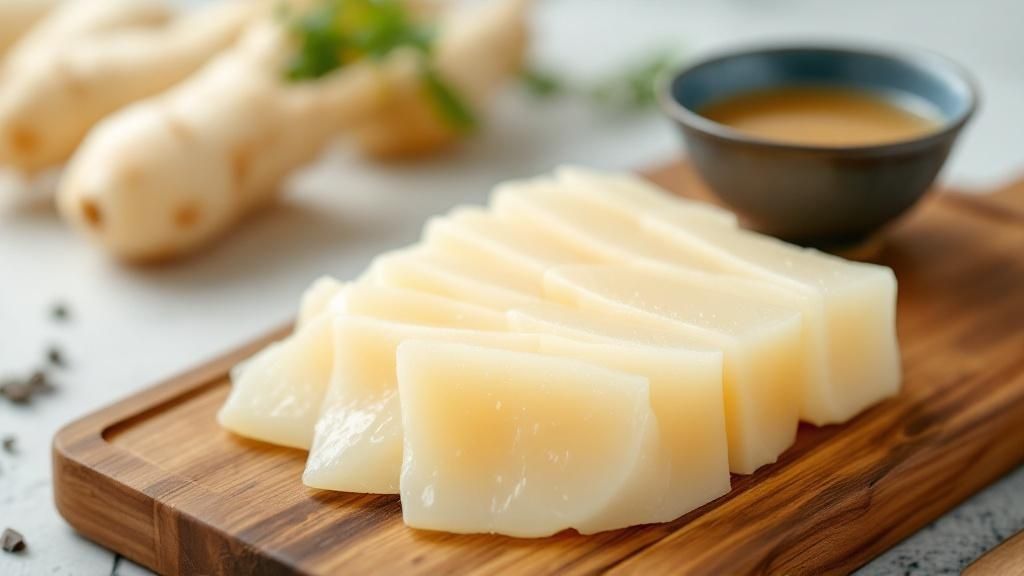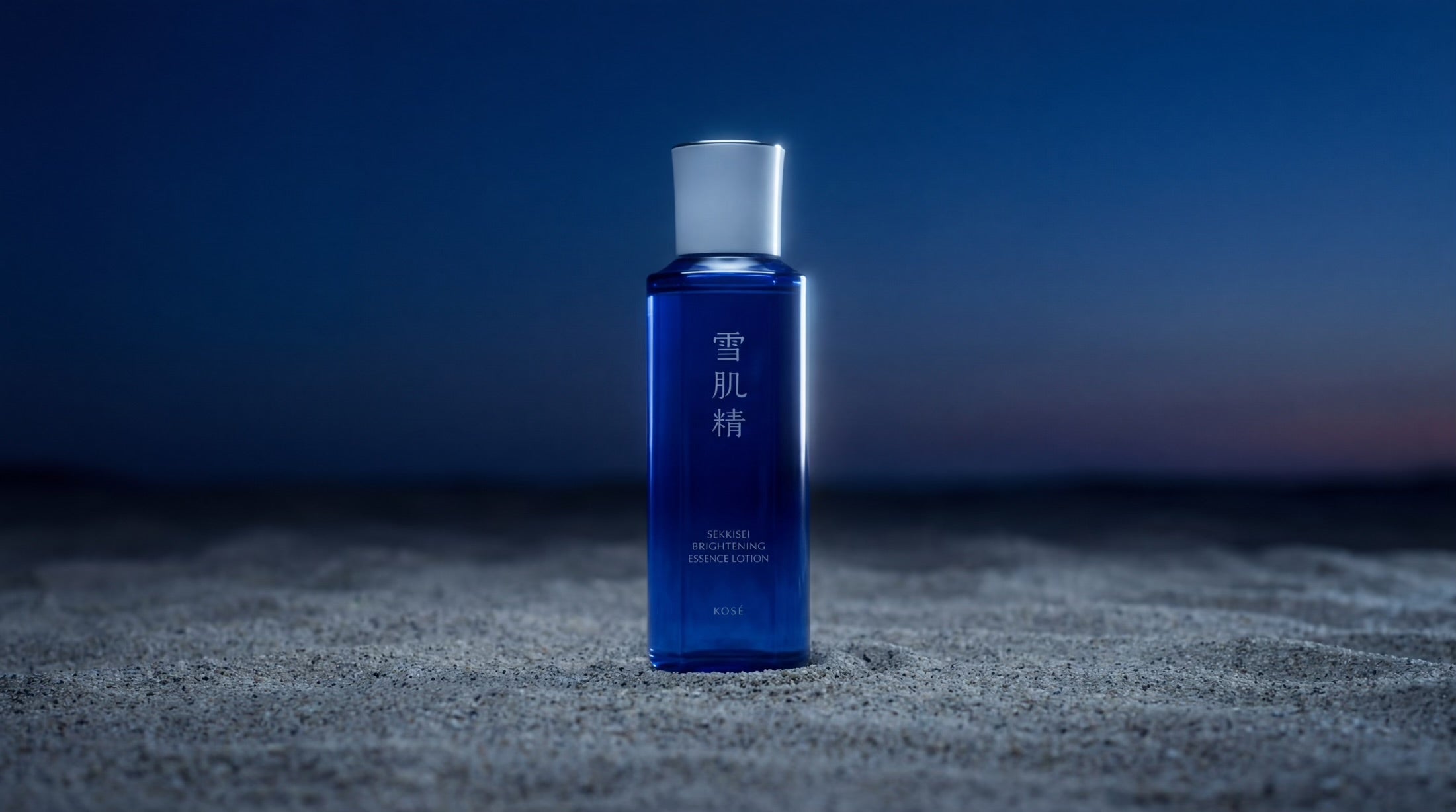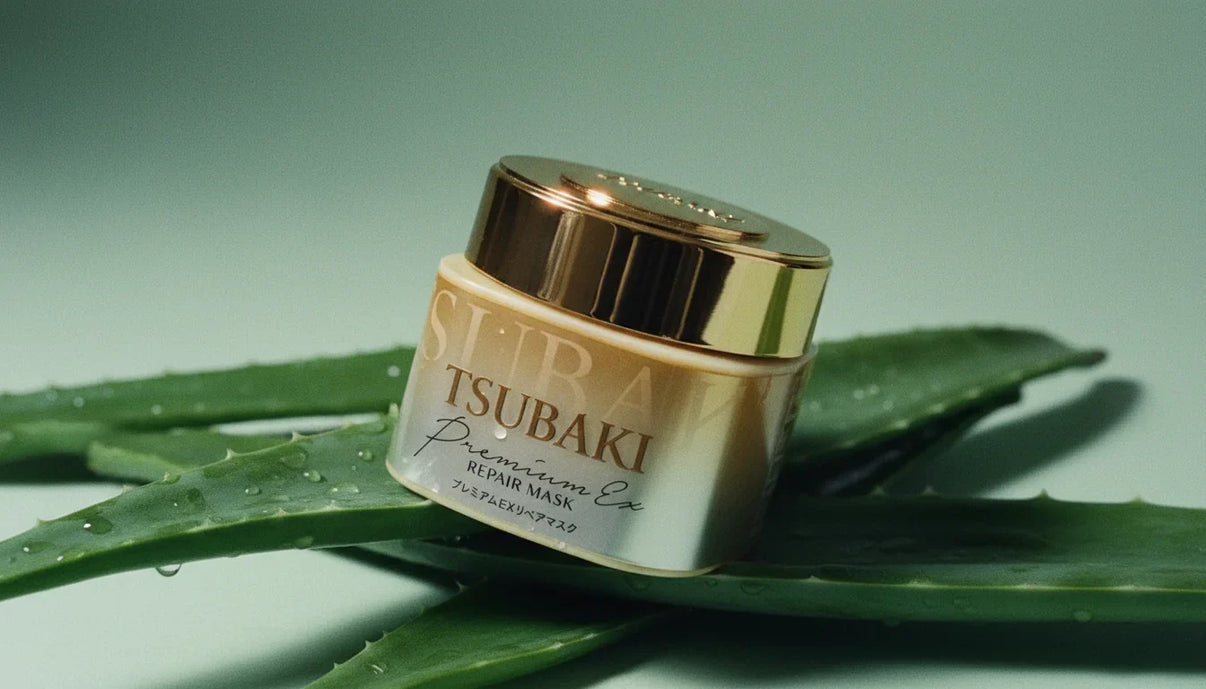Ever come across a strange, jiggly, almost see-through block in a Japanese hot pot or noodle dish and wondered what on earth it was? Chances are, you've met konnyaku, one of Japanese cuisine’s most unique and fascinating ingredients.
At first glance, it can be a little confusing. It’s not tofu, and it’s not gelatin. It’s something else entirely, with a wonderfully firm, springy bite. Think of it as a culinary sponge, brilliant at absorbing the savory broths and rich sauces it's cooked with.
Uncovering a Japanese Culinary Secret
So, what exactly is this culinary chameleon? Konnyaku is made from the root of the konjac plant, a tuber sometimes called the "devil's tongue yam," which grows in parts of Asia. It's been a staple food in Japan for well over 1,500 years, originally prized for its satisfying texture and incredibly low calorie count.
The traditional process is pretty straightforward: the konjac root is ground into a fine flour, then mixed with water and a natural gelling agent. This mixture sets into the firm, jelly-like block you find in stores today. If you're interested in the food science behind it, this konjac dietary fibre report offers a deeper dive into its growing popularity.
What Makes Konnyaku Special?
Here’s the thing about konnyaku: its real magic isn't its flavor. On its own, it’s quite neutral, almost tasteless. Instead, its true strength lies in its incredible texture and versatility.
This neutrality is what makes it such a perfect canvas for flavor. It soaks up everything it’s cooked in, from spicy marinades to rich, umami-packed soups. Its recent rise as a global health food is no surprise either, thanks to an impressive nutritional profile that makes it a fantastic choice for all sorts of dietary needs.
At its core, konnyaku is a high-fiber, low-calorie food that adds satisfying substance to meals without adding weight. It’s the ultimate canvas for flavor.
To give you a quick snapshot, let's break down its key features.
Konnyaku At a Glance
Here's a simple table summarizing what makes konnyaku, well, konnyaku.
| Attribute | Description |
|---|---|
| Primary Ingredient | Flour from the konjac plant root |
| Texture | Firm, gelatinous, and chewy |
| Flavor Profile | Almost tasteless, absorbing surrounding flavors |
| Calorie Count | Extremely low, often near zero |
| Key Component | High in glucomannan, a soluble dietary fiber |
Essentially, it's a simple, ancient food that packs a punch in terms of health benefits and culinary potential.
How Traditional Konnyaku Is Made
 The journey of konnyaku from a rugged mountain plant to a kitchen staple is a fascinating story of traditional craftsmanship. This process, which has been honed over centuries, transforms the humble konjac root into the familiar jiggly block we know and love. It all begins with the harvest.
The journey of konnyaku from a rugged mountain plant to a kitchen staple is a fascinating story of traditional craftsmanship. This process, which has been honed over centuries, transforms the humble konjac root into the familiar jiggly block we know and love. It all begins with the harvest.
Farmers, often in mountainous regions like Japan’s Gunma Prefecture, carefully cultivate and harvest the konjac corm—a tuber sometimes called the "devil's tongue yam." Once pulled from the earth, these large roots are thoroughly cleaned, peeled, and left to dry.
The dried corms are then meticulously ground into a fine, grayish powder known as konjac flour or konnako. This flour is the foundational ingredient, but it's the next step where the real magic happens.
The Transformation Process
Turning this flour into edible konnyaku is a surprisingly simple yet precise process. It’s a technique that has remained largely unchanged for generations, showcasing a deep understanding of food chemistry long before it was formally studied.
Here’s a simplified breakdown of the traditional method:
- Mixing the Flour: The konjac flour is slowly mixed with water, which creates a thick, viscous paste. Getting the consistency just right is key to ensuring a smooth final product.
- Adding the Coagulant: A small amount of limewater (calcium hydroxide) is stirred into the paste. This alkaline solution is the secret ingredient that triggers the gelling process, causing the glucomannan fibers in the flour to cross-link and solidify.
- Shaping and Boiling: The mixture is poured into molds to form blocks or extruded to create noodles. These shapes are then boiled in water, which firms up the jelly, neutralizes the limewater, and makes the konnyaku ready to eat.
The use of limewater is the critical step that gives konnyaku its signature firm, bouncy, and slightly rubbery texture. Without it, the flour would simply remain a thick paste.
Sometimes, a bit of hijiki seaweed is added to the mixture, which gives the final block a speckled, darker look and a subtle hint of oceanic flavor. This fundamental process is a cornerstone of many traditional preparations.
For those eager to explore more foundational techniques, you can learn more about Japanese cooking basics in our other guides. This age-old craft gives you a newfound appreciation for the humble, versatile block you see in stores today.
The Health Benefits of Konnyaku

In health-conscious circles, you'll often hear konnyaku called a 'miracle food', and honestly, it’s not hard to see why. Its incredible wellness profile boils down to one superstar ingredient: glucomannan. This is a powerful type of soluble fiber that makes up almost everything in konnyaku, and it's the secret behind its most impressive health perks.
For many people, the biggest draw is how konnyaku helps with weight management. When you eat it, the glucomannan fiber soaks up water in your digestive tract and expands, which helps you feel full and satisfied. This simple trick can help you cut down on overall calories without feeling like you're starving, making it a fantastic addition to any balanced diet.
In Japan, konnyaku has a charming nickname: "the broom of the stomach." It perfectly captures how it gently sweeps through your digestive system, helping with regularity and supporting great gut health.
A Digestive and Metabolic Ally
Beyond just making you feel full, glucomannan also works as a prebiotic. What does that mean? It basically becomes food for the good bacteria living in your gut, which is absolutely vital for a healthy digestive system. A happy, well-fed gut microbiome is key to better digestion and overall wellness—a core concept you’ll see when exploring https://buymejapan.com/blogs/japanese-skincare-and-beauty/is-japanese-food-healthy-what-really-makes-it-so-powerful.
The benefits don't stop there; they extend to your metabolic health, too. That same unique fiber is fantastic for its ability to help stabilize blood sugar levels, a huge plus for anyone keeping an eye on their metabolic health. It works by slowing down how quickly your body absorbs sugars and carbs from other foods you eat in the same meal.
This growing awareness of konnyaku's health properties is why you’re seeing it pop up more and more around the world. In fact, the global market for food-grade konjac is expected to hit about USD 1.5 billion in the next few years, showing just how popular it's becoming.
Since it’s practically free of calories, carbs, sugar, and fat, konnyaku is a perfect fit for a wide range of eating plans:
- Keto and Low-Carb Diets: It has almost zero net carbs, making it an easy choice.
- Gluten-Free Lifestyles: It's naturally gluten-free, no questions asked.
- Calorie-Conscious Eating: You can add bulk and a satisfying texture to your meals for a negligible calorie count.
A Guide to Different Types of Konnyaku
 When you first encounter konnyaku, you’ll probably see the classic gray, wobbly block. But that’s just the beginning of the story. Konnyaku actually comes in a surprising variety of shapes and sizes, and each one has a specific job to do in the kitchen.
When you first encounter konnyaku, you’ll probably see the classic gray, wobbly block. But that’s just the beginning of the story. Konnyaku actually comes in a surprising variety of shapes and sizes, and each one has a specific job to do in the kitchen.
The most famous type, especially outside of Japan, is Shirataki. The name literally means "white waterfall," and once you see these thin, translucent noodles, it makes perfect sense. They have become a global sensation for health-conscious eaters as a fantastic pasta substitute, soaking up the delicious flavors of soups, stir-fries, and sukiyaki without adding a lot of calories.
A close cousin to Shirataki is Ito Konnyaku. These are also threads, but they tend to be a little bit thicker. The main difference often comes down to regional cooking traditions, but they serve a similar purpose in dishes where you want a more substantial, noodle-like bite.
Beyond the Noodles
Moving past the noodle forms, you’ll discover other fascinating shapes that are absolute staples in Japanese home cooking. Each one offers a completely different textural experience.
- Tama Konnyaku: These are small, savory balls you'll often find bobbing on skewers in oden, a classic Japanese winter stew. Their round shape gives them a delightful, chewy pop that’s incredibly satisfying.
- Sashimi Konnyaku: This unique variety is specially crafted to be eaten raw. It's often flavored with ingredients like zesty yuzu or savory seaweed and sliced paper-thin. Served with a simple dipping sauce of soy sauce and wasabi, it makes for a wonderfully refreshing appetizer.
Key Takeaway: The shape of konnyaku isn't just for show; it completely changes how it feels and functions in a dish. A sturdy block is perfect for simmering in stews, while delicate noodles are born to soak up flavorful broths.
Exploring these different forms really helps you appreciate just how versatile this amazing ingredient is. Of course, a healthy diet is just one part of overall wellness. If you're looking to support your body in other ways, you might be interested in our guide on the top Japanese health supplements for a healthier you.
How to Prepare and Cook With Konnyaku
Ready to bring konnyaku into your kitchen? It might seem a little unusual at first, but cooking with this unique ingredient is incredibly simple once you master a few basic steps. These tips will give you the confidence to start using it right away.
The biggest hurdle for newcomers is often preparing the block of konnyaku. When you first open the package, you might notice a slightly earthy or "fishy" aroma. Don't worry—this is completely normal and just comes from the mineral-rich water it's packed in. Getting rid of it is a breeze.
First, always drain and rinse the konnyaku thoroughly under cold, running water. The next step is absolutely crucial: parboil it for 2-3 minutes. This simple trick gets rid of any lingering odor and vastly improves its texture, making it ready to absorb all the delicious flavors you throw at it.
Maximizing Flavor and Texture
Once your konnyaku is rinsed and parboiled, there's one more trick to help it soak up sauces and broths like a sponge. Simply score the surface by making shallow, crisscross cuts across the block. This increases the surface area, turning it into the ultimate flavor vehicle.
Key Tip: Scoring konnyaku is a total game-changer. Not only does it help the block absorb marinades and broths, but it also keeps the surface from getting too rubbery when you pan-fry it, creating a much more pleasant bite.
With your konnyaku all prepped, it's time for the fun part—cooking! To weave it into your daily meals, you can explore some simple clean eating recipes that really let its unique texture and health benefits shine.
Here are a few easy, entry-level ideas to get you started:
- Sukiyaki or Hot Pot: Add diced or twisted konnyaku to a rich, simmering broth. It will soak up all that savory goodness.
- Quick Stir-Fry: Use shirataki noodles as a fantastic low-carb swap for regular noodles. They cook in minutes and absorb the flavors of your stir-fry sauce beautifully.
- Pan-Fried "Steak": Slice the konnyaku block into thick "steaks," score them, and pan-fry with soy sauce, mirin, and garlic for a savory, chewy side dish.
For even more inspiration, be sure to check out our guide to easy Japanese recipes, perfect for any night of the week.
Where to Find and Buy Konnyaku

Ready to add konnyaku to your kitchen? Finding it is much easier than you might think, especially as its reputation as a fantastic health food continues to grow.
Your best bet is almost always the refrigerated section of an Asian grocery store. That's where you'll discover the most extensive selection—from the classic jiggly blocks and shirataki noodles to the little round tama konnyaku balls.
Even many larger, mainstream supermarkets have started stocking konnyaku in their international or health food aisles. Just look for it in water-filled bags, usually right next to the tofu. Health food stores are another reliable spot, especially if you're hunting for gluten-free pasta alternatives like shirataki.
Online Shopping and What to Look For
Of course, online shopping makes getting your hands on high-quality konnyaku incredibly easy. On sites like Buy Me Japan, you can browse different types from trusted Japanese brands and have them sent straight to your home. When you're shopping, just be sure to check the packaging to see what form you're buying—a block, noodles, or a pre-seasoned snack.
The global demand for healthy, plant-based foods has really pushed konnyaku into the spotlight. It's quickly gone from being a niche Japanese staple to a mainstream wellness product you can find almost anywhere.
This surge in popularity is easy to see in the market for konnyaku-based products, like those famous fruit jelly snacks. The global market for konnyaku jelly recently shot past USD 130 million and is set to keep growing as more people look for low-calorie treats that are good for digestion. You can dive deeper into this market trend and its drivers in this detailed report.
And if you're building a holistic wellness routine, you might be interested in more than just what's on your plate. Check out our guide on the 7 best Japanese collagen supplements to try to support your health from the inside out.
Answering Your Konnyaku Questions
As you get to know this unique Japanese food, you're bound to have a few questions pop up. We've gathered answers to the most common queries beginners have, helping you feel much more confident about bringing konnyaku into your kitchen.
What Does Konnyaku Taste Like?
On its own, konnyaku is virtually tasteless and has no smell after a quick rinse. Its real magic lies in its uniquely firm, chewy, and almost gelatinous texture. Think of it as a blank canvas just waiting for flavor.
Because it’s so porous, it’s an absolute master at soaking up the broths, sauces, and marinades it's cooked in. This neutrality is exactly what makes konnyaku such a versatile and exciting ingredient in so many dishes.
Is Konnyaku the Same as Shirataki Noodles?
That's a fantastic question, and the answer is both yes and no. They both come from the exact same source—the konjac plant—but they're prepared in different forms. The term konnyaku usually refers to the solid, jelly-like block you can slice or cube.
Shirataki noodles, on the other hand, are a specific type of konnyaku that has been shaped into thin, translucent noodles.
A simple way to remember it: All shirataki is konnyaku, but not all konnyaku is shirataki.
Why Does My Konnyaku Have a Strange Smell?
It’s very common to notice a slightly "fishy" or earthy smell from the liquid konnyaku is packed in. This is completely normal! It just comes from the mineral-rich water used to set the jelly during production.
The fix is incredibly simple: just drain the konnyaku, rinse it thoroughly under cold water, and then parboil it for 2-3 minutes. This essential step gets rid of the odor completely and preps it to absorb all the delicious flavors of your dish.
Can You Eat Konnyaku Raw?
Yes, but typically only specific types are meant to be eaten raw. You'll want to look for products labeled "sashimi konnyaku," which are often flavored with things like yuzu or seaweed and have a much softer texture perfect for eating uncooked. These are usually served chilled with a dipping sauce, like soy sauce and wasabi.
For the standard blocks of konnyaku, you'll almost always want to cook them. Cooking not only helps them absorb flavor but also improves their signature bouncy texture.
Ready to try this amazing ingredient for yourself? Explore a wide selection of authentic konnyaku and other Japanese foods at Buy Me Japan. Start shopping now and discover your new favorite pantry staple!




Share:
How to Brew Japanese Green Tea: Easy Step-by-Step Guide
8 Inspiring Japanese Bento Box Ideas for 2025